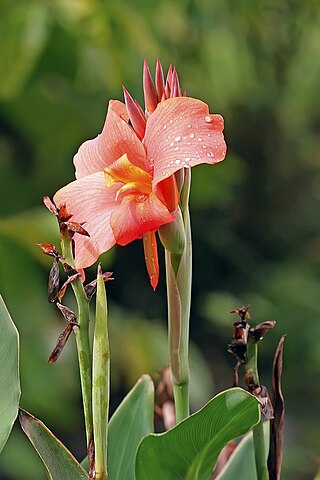
Canna or canna lily is the only genus of flowering plants in the family Cannaceae, consisting of 10 species. All of the genus's species are native to the American tropics and were naturalized in Europe, India and Africa in the 1860s. Although they grow native to the tropics, most cultivars have been developed in temperate climates and are easy to grow in most countries of the world, as long as they receive at least 6–8 hours average sunlight during the summer, and are moved to a warm location for the winter. See the Canna cultivar gallery for photographs of Canna cultivars.
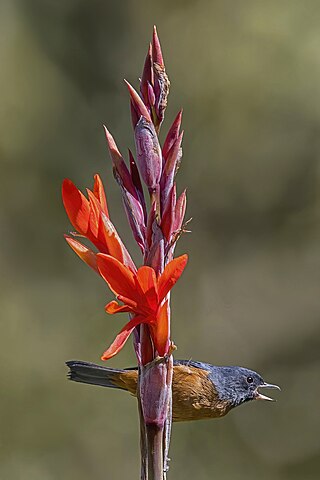
Canna indica, commonly known as Indian shot, African arrowroot, edible canna, purple arrowroot, Sierra Leone arrowroot, is a plant species in the family Cannaceae. It is native to much of South America, Central America, the West Indies, and Mexico. It is also naturalized in the southeastern United States, and much of Europe, sub-Saharan Africa, Southeast Asia, and Oceania.

Canna glauca is a species of the Canna genus, a member of the family Cannaceae. It is commonly known as water canna or Louisiana canna. It is native to the wetlands of tropical America and was introduced to England in 1730. It is also reportedly naturalized in Sri Lanka, Thailand, Vietnam, Java and the Philippines.

Canna flaccida is a species of the Canna genus, a member of the family Cannaceae. The species is indigenous to the wetlands of the south-central and south-eastern United States from Texas to South Carolina. It is also reportedly naturalized in India, the Philippines, Mexico, Panama, Cuba, the Dominican Republic, Peru and southern Brazil.
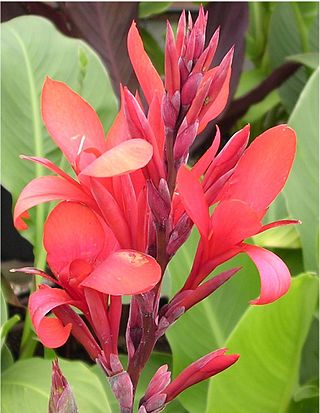
Canna coccinea is a species of the Canna genus, belonging to the family Cannaceae. A native of northern Argentina, it was introduced in England from South America in 1731.
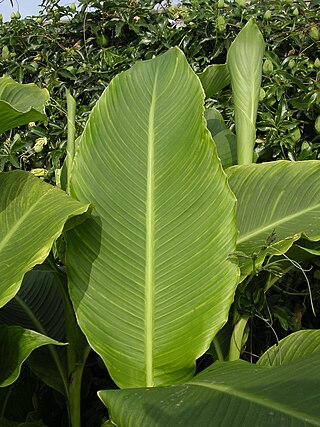
Canna tuerckheimii is a species of the Canna genus, belonging to the family Cannaceae. Its specific epithet tuerckheimii commemorates Hans von Türckheim, a 19th-century German plant collector.
Canna bangii is a species of herb in the family Cannaceae. It is native to Peru and Bolivia.
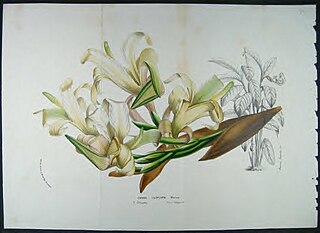
Canna liliiflora is a species of herb in the family Cannaceae. It is native of Peru and Bolivia.

Canna patens is a species of herb in the Cannaceae family.
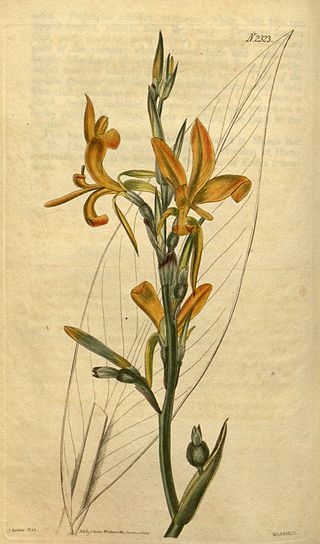
Canna pedunculata is a species of the Canna genus, belonging to the family Cannaceae. Native of south-east Brazil at low altitudes. Johnson's Dictionary of 1856 reports that it first entered England in 1820, pedunculata meaning 'long-flower-stalked'.

Canna jaegeriana is a species of herb in the family Cannaceae.

Canna paniculata is a species of flowering plant in the family Cannaceae. It is native of southern Mexico, Costa Rica, and tropical South America, except for the Amazon Basin, at 200-2,000m (650-6,500 ft).
Canna 'Musaefolia' is a cultivar in to the Foliage Group of Cannas. The cultivar was first described in the first work devoted to Canna, Le Canna, authored by M. Chaté in 1867 with Monsieur Théodore Année. The Musaefolia members of the Foliage Group consist of a specimen that was accepted as a native species of Peru by the experts of the time and at least 7 hybrids and cultivars carrying that parentage. The original "species" was unique because it was without rhizomes, and required to be kept constantly growing. No such species is known to exist in this age, and leading authorities treat C. musaefolia as a synonym of C. paniculata.

Citronella mucronata, the huillipatagua, naranjillo, or Chilean citronella tree, is an evergreen tree in the family Cardiopteridaceae. It is endemic to Chile and grows in the Chilean matorral region of central Chile from 30º to 40° south latitude.

Bowlesia incana is a species of flowering plant, known by the common name hoary bowlesia, in thefamily Apiaceae. It is native to South America and the southeastern and southwestern United States as far north as Washington. It can also be found in Pakistan and New Zealand as an introduced species. It grows in many types of habitat. This is a small annual herb growing thin, spreading stems less than 60 centimeters long. The leaves are borne on long petioles and have multilobed rounded or kidney-shaped blades less than 3 centimeters wide. The green herbage of the plant is coated in fine white hairs. The inflorescences of yellow-green flowers appear in the leaf axils. The tiny inflated fruit is only 2 millimeters wide.
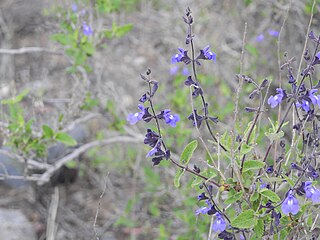
Salvia cuspidata is a species of perennial shrub in the family Lamiaceae. It is native to the Andes mountains in Bolivia, Chile, and Peru, growing at elevations up to 10,000 ft (3,000 m).

Salvia oppositiflora is a species of perennial flowering plant in the famiily Lamiaceae. It is native to Peru, growing at high elevations—7,000 to 12,000 feet. It was collected in 1798 by Hipólito Ruiz López and José Antonio Pavón Jiménez and later described in Flora of Peru.

Salvia sagittata is a species of herbaceous perennial plant in the family Lamiaceae. It is native to the Andes Mountains, growing at elevations from 9,500 to 10,500 ft. The specific epithet refers to the arrow-shaped leaves. The plant was collected and named in 1798 by Hipólito Ruiz López and José Antonio Pavón Jiménez, two Spanish botanists who spent ten years in Peru and Chile on a commission by the government of Spain to go to the New World in search of new medicinal and agricultural plants.

Clinanthus is a genus of bulbous plants in the family Amaryllidaceae. It is found in western South America, including Ecuador, Peru, Bolivia, north Chile and north west Argentina.

Escallonia rubra, called redclaws and red escallonia, is a species of flowering plant in the family Escalloniaceae. It is native to southern Chile and neighboring areas of Argentina.


















